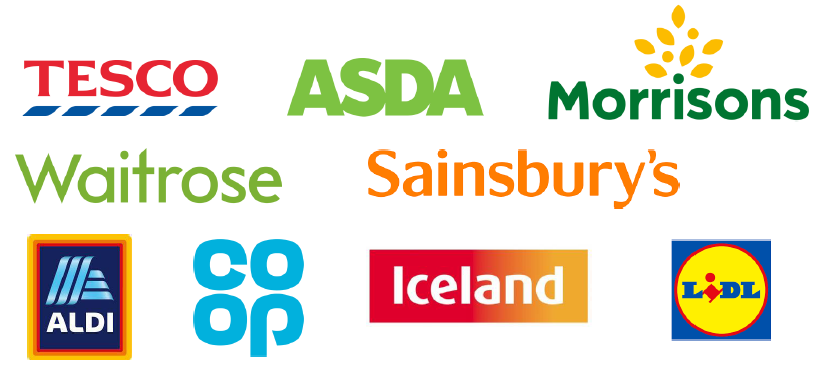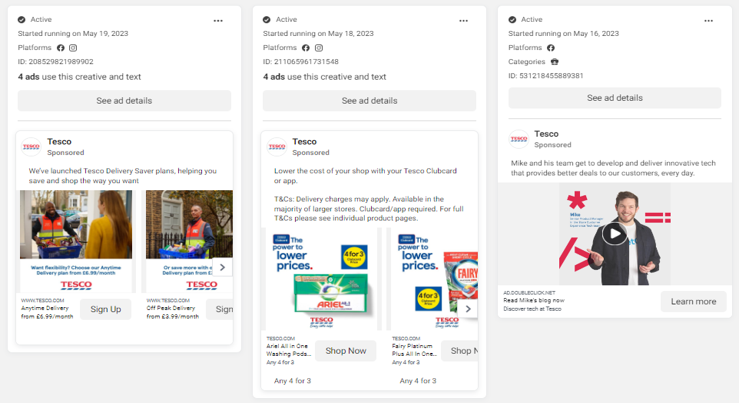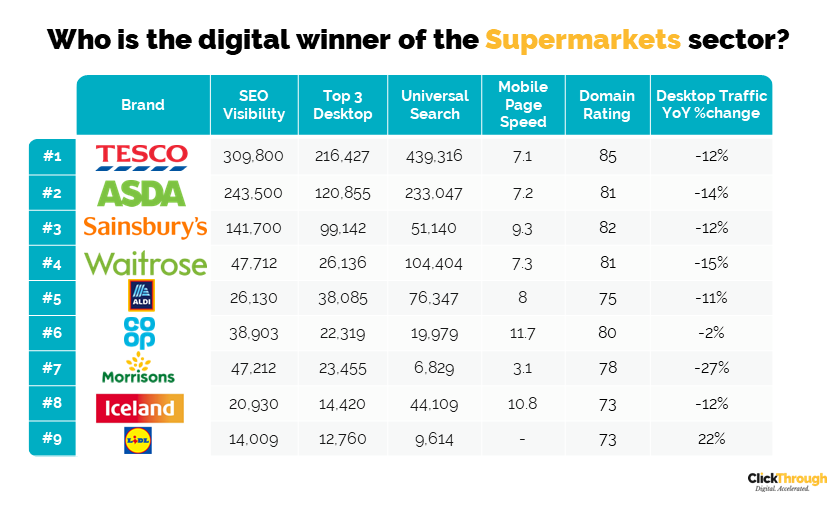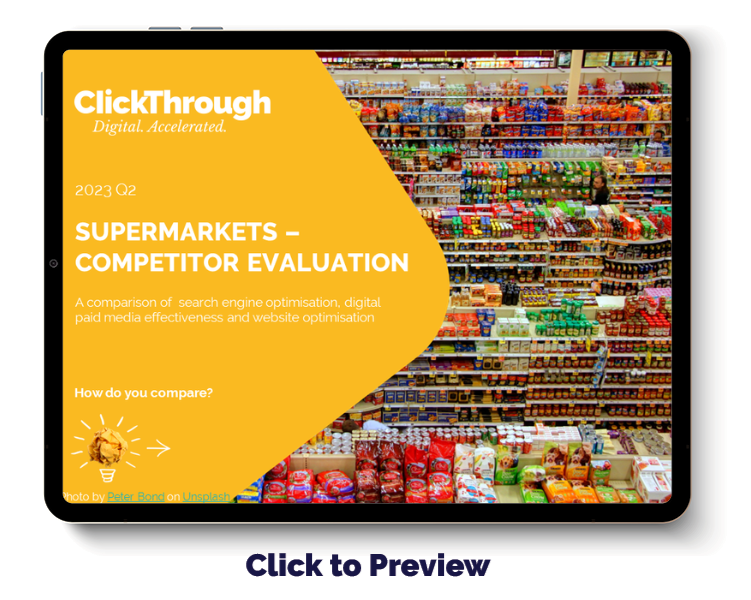The Q2 2023 benchmarking report for UK supermarkets has just been published. Learn how the top 9 UK supermarkets perform across the digital space.
The latest Q2 2023 benchmarking report for UK supermarkets has just been published. It covers the largest 9 national supermarkets, including Tesco, Asda, Waitrose, Aldi, Iceland, Co-op, Lidl, Morrisons, and Sainsbury’s - it highlights year-on-year digital performance, plus winner and loser comparisons in 20+ online performance metrics.

The research gives an inside track on who is winning the biggest share of voice online, and quantifies the gaps, risks and missed opportunities for other supermarkets to win brand exposure, generate online orders, and drive in-store footfall. The report highlights quick wins that will improve enquiries from your online strategy and identifies the barriers that may be reducing your site’s ability to optimise digital performance.
To see a preview and contents page of the Q2 report, click here. To get a copy of the full report and the key takeaways, please complete the enquiry form or schedule a call.
What The Industry Research Report Covers
The 70+ pages of research benchmarks each brand based on 50+ metrics and indicators of successful digital strategy, including organic visibility, domain authority, paid media ads, conversion performance, technical performance, site speed, universal search, content, social ads, accessibility, and mobile performance.
Driving Optimal ROAS from Paid Media Channels
Some of the leading players in the space are high spenders on paid media channels such as Google, Bing & Facebook - but have a poor or sub-optimal conversion improvement strategy. Without an optimised, sophisticated conversion strategy that maximises the conversion rate, the return on investment is unsustainable or will underperform. Scaling spend on paid media is not achievable unless the conversion rate delivers optimal performance in the sector. Some in the space have paid media spend levels from 30k+ per month but dedicate minimal resources and budgets to conversion testing. Given the cost per clicks on ad networks will continue to rise, we recommend spending at least 10% of your paid media budget on ongoing conversion optimisation testing schedules to ensure your paid media ROI maintains long-term viability, competitive advantage, and sustainability.
Technical Website Compliance
Savvy digital marketers know that having a technically sound website is an essential component of a successful fully integrated digital strategy - plus a site capable of maximising conversion performance. Supermarkets may find it challenging to stay on top of technical performance, due to the huge volume of product pages that they will need to maintain.
Despite the need to stay on top of thousands of products, most of our supermarkets have kept error codes to a minimum. However, our crawl returned 857 4xx error codes from Sainsbury's, a significant increase from our previous reports. Sainsbury's must be sure that the removal of any product lines is not leading customers down dead ends, and that they are being redirected to similar products or ranges.
Site Speed & Conversion Rate Performance
When 62% of consumers are less likely to convert if they have a negative mobile site experience, ensuring that your site is quick and easy to load makes a significant improvement on your overall conversion rates. Managing large sites can prove challenging when needing to maintain mobile page speed performance, but supermarkets can mitigate this by using smaller images where possible.
In our last report, we noted that only Sainsbury's were achieving an 'okay' mobile page speed score, with 64. While Sainsbury's have now dropped to a score of 36, Co-op have leapt ahead with a score of 74. Though this still sits within the 'okay' bracket of 50-89, this is one of the highest mobile page speed scores we have seen across any sector.
Building Competitive Advantage with Domain Authority
Domain authority is an essential metric for measuring the effectiveness of SEO performance and helps create a reliable overall gage of how effective your site is at achieving organic traffic, ie. ‘free’ traffic that isn’t gained through sponsored ads. Supermarkets have the opportunity to build their backlink profile and authority by capitalising on the huge range of products and brands that they stock. They can also run and take part in events within their local communities and for charities, helping them maintain their brand image, as well as securing links.
Domain authority is considered average between 40 and 50, good between 50 and 60, and excellent above 60. ‘Good’ DA score depends on the competition level of the industry.
Domain authority for all supermarkets remains strong, with scores ranging from 84 for Tesco, to 73 for Lidl. Realistically, these exceptional scores are difficult to improve on, though each supermarket should still look to maintain a strong digital PR strategy in order to maintain brand awareness and recognition.
Organic Performance – Mobile & Desktop
A strong organic performance is strategically important as it ensures your site ranks above competitors for key, transactional keywords. When 93% of your customers won’t go past the first page of Google, your absence or lack of targeting for essential keywords will cost you conversions.
Though desktop remains the most popular avenue for traffic for supermarkets, only Aldi were able to improve on their 2022 organic desktop traffic, with a rise of 11%. All other brands saw a reduction in desktop organic traffic year on year. However, looking at mobile traffic, each supermarket saw an increase. Though Morrisons saw the largest decrease in desktop traffic (losing 27% of organic visits year on year), they saw the second largest increase in mobile traffic of all eight supermarkets, with 9%.
Universal Search Opportunity
Google Universal Search Results is an evolving opportunity to make your pages visible on a SERP (Search Engine Results Page). Universal results often appear before traditional listings and are eye-catching for users. Universal search results refer to rankings on a SERP that are not the traditional ‘blue line’ Google link, and a brand can appear for universal search results without being strong in standard rankings. 'Reviews', 'Local Pack', and 'People Also Ask' results are all useful results for supermarkets to target, helping them deliver additional information, directly on the SERP.
We've noted in our previous two reports that Tesco have been the strongest players in the Universal Search game. This remains true this quarter, with over 200,000 more appearances than any other supermarket. 'Reviews' make up the majority of Tesco's Universal Search results, with 365,100 results - this makes them more likely to capture traffic from customers looking for reviews of specific products, even if they're not including 'Tesco' in their search phrase.
The Longtail Keyword Opportunity
Longtail keywords are often considered high intent and potentially more likely to convert as a searcher is being more specific. Optimising for longtail keywords also puts your content strategy in a strong position to rank for brand-new search terms as they enter Google’s index. Supermarkets showing for more long-tail keywords than their competitors can expect to scoop up traffic from lower-funnel search terms that are more likely to lead to a conversion or sale.
We've noted that Lidl have been steadily improving on longtail keywords, and are now ranking in the top three positions for 8,323 longtail search terms. Looking more broadly across the other supermarkets' performance, while Asda rank for the most longtail keywords overall, Tesco have secured the most appearances in the top three positions, showing a more thorough and well-considered approach to quality rankings over quantity.
Facebook Adverts
With the number of Facebook users in the United Kingdom (UK) forecast to hit over 42 million users by 2022, it is not surprising that companies have jumped at the opportunity to advertise on the social media platform. Facebook’s UK digital advertising revenue has been estimated to have breached 2.6b GB pounds in 2019. For supermarkets, they can use Facebook ads to drive in-store and online footfall in high-competition areas, along with ensuring visibility on key events and product lines.
Tesco have used Facebook ads to increase awareness of a number of services. Below, we've included their recent ads promoting their delivery saver plans, the Tesco Clubcard, and their technology offering. In the case of the Clubcard and delivery saver plans, they've appealed to financially conscious customer, who'll be looking to make smarter choices during the current cost of living crisis. The carousel in the Clubcard creative uses a simple design that would make it easy to swap out product images depending on current offers. This makes it a low-maintenance, but high-impact ad that quickly improves visibility on key savings.

Top Social Shares & Content
When it comes to social media and on-site content strategies, it is important to release content that has a longer shelf life. An article is considered 'Evergreen' if it has maintained its relevancy to an audience for longer. It's great for your brand engagement, but great for Google too, who will recognise content which achieves traffic over a long period of time. Supermarkets can draw on content across their full range of products, using recipe content, home advice, and seasonal product lines to appeal to topical subjects and drive engagement.
Lidl stood out to us as being the only brand favouring Pinterest as a platform. This is a smart move, as the platform is a popular destination for recipe content and home inspiration, helping Lidl gain visibility for both their food and special products. A glance at Lidl's profile reveals strong, colourful pins and regular calls to action to visit the brands YouTube channel too. With boards relating to seasonal content such as summer, easter, mothers day, and Halloween, Lidl can also expect these pins to gain popularity year after year.
Website Readability & Accessibility
20% of people in the UK have a disability – 2 million of which are people living with sight loss. In addition, 1 in 12 men and 1 in 200 women have some degree of colour vision deficiency. When websites are not designed to meet these needs, brands lose customer interest as they turn elsewhere. Grocery shopping is essential for everyone, so supermarkets should ensure their sites are accessible and do not exclude customers with additional accessibility needs.
In our last report, we saw that Aldi had reduced their alerts figure, from 438 down to just one. We're happy to see that Aldi have maintained performance here, showing for just one error and one alert. Lidl returned the highest volume of alerts of all supermarkets, with 75 - though alerts may not be critical, they can often point to page elements that could be a challenge for screen readers, used by customers with severe visual impairments.
Q2 2023 Winners and Losers Summary
For a glance into just 6 of the metrics we evaluated these top 9 supermarkets on, check out our quick-look table below;

GET THE FULL 79-PAGE Q2 2023 REPORT
To get a copy of the full report, please complete the enquiry form. If you want to talk to us about accelerating your digital performance, please call us on 01543 410014 or schedule a call with Mike Movassaghi.
Photo by Markus Spiske on Unsplash






Let's be social
Join our growing social communities to learn more about the benefits of digital marketing and the people who make us tick.